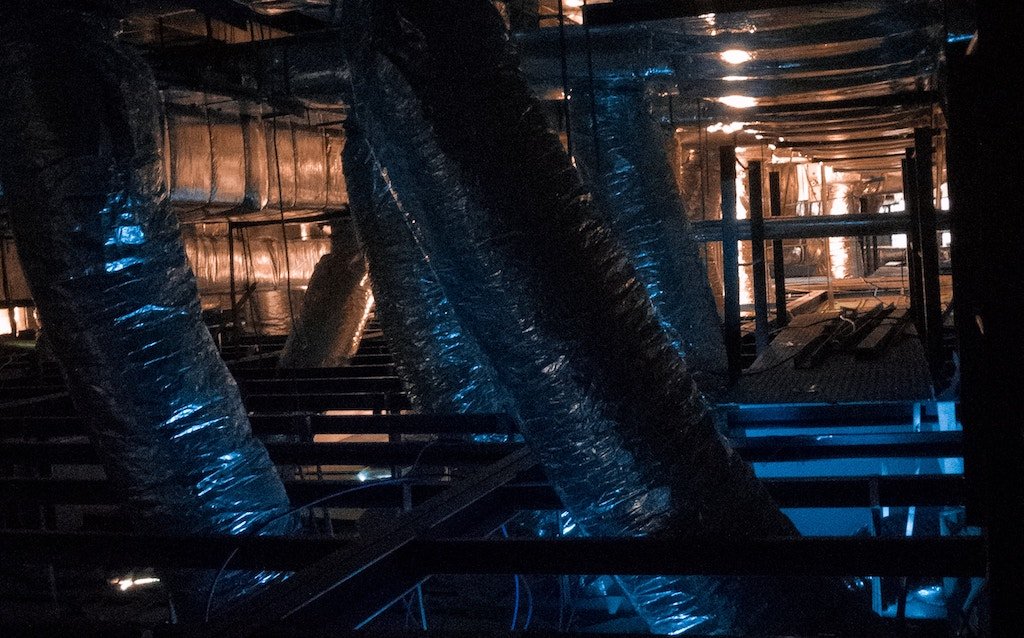Do Home Warranties Cover Ductwork?
When protecting your home, a home warranty can be a valuable investment. A home warranty provides coverage for the repair or replacement of major appliances and systems. But what about your HVAC ductwork? Does a home warranty cover these vital components of your home’s heating and cooling system? In the following, explore the topic of ductwork coverage, shed light on what is and isn’t covered, and provide valuable maintenance tips to ensure the longevity and efficiency of your ductwork.
What is ductwork?
Ductwork is an integral component of the HVAC system in residential and commercial buildings. It consists of a network of interconnected ducts that carry conditioned air, whether heated or cooled, to different areas of the building. Ductwork is designed to ensure proper airflow, temperature regulation, and ventilation throughout the structure. The primary materials used in ductwork construction are sheet metal, fiberglass, or flexible plastic. Sheet metal ducts are commonly used in larger commercial buildings, while fiberglass and flexible plastic ducts are more prevalent in residential settings due to their ease of installation and flexibility.
The main function of ductwork is to distribute conditioned air from the HVAC system’s main unit, such as a furnace or air conditioner, to individual rooms or zones within the building. The ducts are strategically routed through walls, ceilings, floors, and crawl spaces to deliver air to various vents or registers.
Ductwork also facilitates the return of air back to the HVAC system for reconditioning. Return ducts, separate from supply ducts, draw air from various rooms or zones and bring it back to the central unit for filtering, heating, or cooling.
The design and layout of ductwork ensure optimal airflow and efficiency. Properly sized and installed ductwork minimizes pressure imbalances, reduces energy consumption, and helps maintain consistent comfort levels throughout the building. Professional HVAC technicians use industry-standard guidelines and calculations to determine the appropriate duct size and layout based on factors such as the building’s size, number of rooms, and heating or cooling requirements.
Is ductwork covered by a home warranty?
When it comes to ductwork warranty and home warranty coverage, understand that coverage for ductwork can vary significantly depending on the terms and conditions of your home warranty contract. Typically, home warranties are designed to primarily focus on major appliances and essential systems within your home, including HVAC units, electrical systems, plumbing, and kitchen appliances. Ductwork, on the other hand, is typically considered part of the house’s structural components rather than a standalone appliance or system, and as such, it’s often not automatically included in standard home warranty coverage.
However, there are situations where homeowners may seek coverage for their ductwork, especially if they have concerns about its condition or performance. Some home warranty providers do offer optional coverage for ductwork, but this is usually provided as an add-on feature or as part of enhanced warranty plans. In other words, coverage for ductwork is not a default inclusion in a basic home warranty; homeowners may need to specifically request or select it as an additional option when purchasing their warranty plan.
To determine whether your home warranty includes coverage for ductwork and to understand the specifics of such coverage, it’s essential to review your home warranty contract carefully. This contract will outline the scope of coverage, any optional add-ons, and any conditions or limitations that may apply. If you have questions or need clarification on your ductwork coverage, don’t hesitate to contact your home warranty provider directly. They can provide you with the necessary information to ensure that your home warranty aligns with your needs and concerns regarding your ductwork and the overall functionality of your home’s systems.
Fixtures associated with ductwork:
While the actual ductwork itself may not be covered, there are fixtures associated with ductwork that may be eligible for coverage under a home warranty. These fixtures include duct registers, grilles, dampers, and vents. Although these fixtures do not encompass the entire ductwork system, they are essential in its functionality.
Duct registers and grilles are visible components that allow airflow into and out of different rooms in your home. Dampers, on the other hand, regulate or block airflow within the ductwork system. Vents refer to the openings in walls, ceilings, or floors where the air is expelled or taken in. Issues can arise with these fixtures over time, impacting the efficiency and performance of your HVAC system.
The coverage of these fixtures under a home warranty varies based on your specific contract. Some home warranty providers include coverage for these fixtures as part of their standard plans, while others offer them as optional add-ons or enhanced coverage options. When covered, a home warranty typically applies to the repair or replacement of malfunctioning or damaged duct registers, grilles, dampers, or vents. For example, if a duct register becomes loose or a vent develops a leak, you may be able to file a claim with your home warranty provider to have the necessary repairs or replacements covered.
How to identify ductwork problems
Identifying ductwork problems is crucial for maintaining a comfortable and efficient home environment. Common ductwork issues can lead to energy wastage, poor indoor air quality, and compromised heating or cooling. Here’s how to identify such problems:
Common Ductwork Issues:
Air leaks: Leaking ducts can waste energy by allowing conditioned air to escape into unconditioned attic or crawl spaces. To identify air leaks, inspect visible duct sections for loose connections, gaps, or visible damage. Also, look for uneven heating or cooling in different rooms, as this can indicate airflow problems.
Restricted airflow: Poor airflow can result from blocked or obstructed ducts. Check for items like furniture, debris, or collapsed duct sections that may hinder proper airflow. Rooms that are consistently too hot or too cold may indicate this issue.
Duct damage: Physical damage to ducts can occur over time due to factors like age, rodents, or construction work. Inspect ducts for dents, holes, or loose joints. Damaged insulation can also lead to energy loss.
Inadequate insulation: Proper insulation prevents heat loss or gain in ducts. Touch the ducts; it may indicate inadequate insulation if they feel noticeably colder or warmer than the surrounding area.
Excessive dust and allergens: If you notice an increase in dust, allergens, or respiratory issues in your home, it could be due to leaks in the ductwork that are drawing in unfiltered air. Look for excessive dust buildup around vents and registers.
Unusual odors or sounds: Strange odors or noises coming from the ducts may indicate mold, pests, or debris accumulation. Investigate these issues promptly.
Identifying Ductwork Problems
Identifying these common ductwork problems involves a combination of visual inspection, monitoring, and sometimes professional assessment. Start by visually inspecting exposed ducts in your home. Look for signs of damage, loose connections, or insulation issues. Notice unusual temperature variations between rooms and any strange sounds or odors.
If problems persist or if you suspect hidden issues within ducts located behind walls or ceilings, it’s advisable to consult with a qualified HVAC technician. They can thoroughly inspect using specialized tools like duct cameras and airflow meters to pinpoint the exact source of problems.
Regular maintenance and inspection can help catch ductwork issues early and prevent energy wastage, discomfort, and potentially costly repairs.
How much does it cost to repair and replace ductwork
The cost of repairing ductwork can vary depending on the damage’s extent and the repair’s complexity. On average, minor repairs such as sealing air leaks or fixing small holes is an average of $550. However, more extensive repairs, such as replacing damaged sections or addressing severe leaks, can cost between $2,000 and $5,000 or more.
Ductwork replacement costs
Ductwork replacement costs can be more significant than repairs, and they depend on various factors, including:
Duct material: The type of duct material you choose can impact the cost. Options include sheet metal, flexible ducts, and fiberglass ductboard.
Duct size and layout: The size and complexity of your duct system, including the number of vents and registers, will influence the cost. Larger homes or those with intricate layouts may require more extensive duct systems.
Accessibility: If the ductwork is challenging to access, such as in tight crawl spaces or within walls, labor costs may increase.
Insulation: Insulating the new ducts can add to the overall cost but can improve energy efficiency.
Tips for maintaining ductwork
Since a home warranty may not cover the actual ductwork, it’s crucial to prioritize proper maintenance.
Regular Inspections: Schedule periodic inspections by a professional HVAC technician to assess the condition of your ductwork. They can identify any leaks, blockages, or damage that may impact the performance of your HVAC system.
Cleanliness Matters: Over time, dust, dirt, and debris can accumulate within the ducts, leading to reduced airflow and potentially compromising indoor air quality. Consider hiring a professional duct cleaning service to remove any buildup and improve overall system efficiency.
Seal Air Leaks: Leaky ducts can significantly impact the efficiency of your HVAC system, leading to energy waste and higher utility bills. Inspect your ductwork for any gaps or leaks and seal them using appropriate materials such as mastic sealant or metal-backed tape.
Filter Maintenance: Regularly clean or replace your HVAC system’s air filters. Clogged filters can restrict airflow, placing additional strain on your system and potentially causing damage to the ductwork.
Mindful Landscaping: Ensure that shrubs, trees, and other vegetation are kept away from outdoor components of your HVAC system, such as the outdoor unit and vents. This helps prevent debris buildup and allows for proper airflow.
While the ductwork itself may not be covered by a standard home warranty, certain fixtures associated with ductwork may be eligible for coverage. Regardless of warranty coverage, regular maintenance of your ductwork is vital for optimal HVAC system performance. By following the tips mentioned, you can keep your ductwork in excellent condition, promoting energy efficiency and ensuring clean and comfortable indoor air quality.
Remember, a home warranty provides comprehensive protection for various aspects of your home, and if you have any questions or concerns about your home warranty coverage, reach out to your provider for clarification. Take control of your home’s comfort and protect your investment by staying informed and proactive.
Don’t wait until issues arise; be proactive about maintaining your ductwork and safeguarding your home’s HVAC system. With the right knowledge and maintenance routine, you can enjoy efficient airflow, improved indoor air quality, and a comfortable living environment.
Discover more about the benefits of home warranties and explore comprehensive coverage options at porchwarranty.com.

